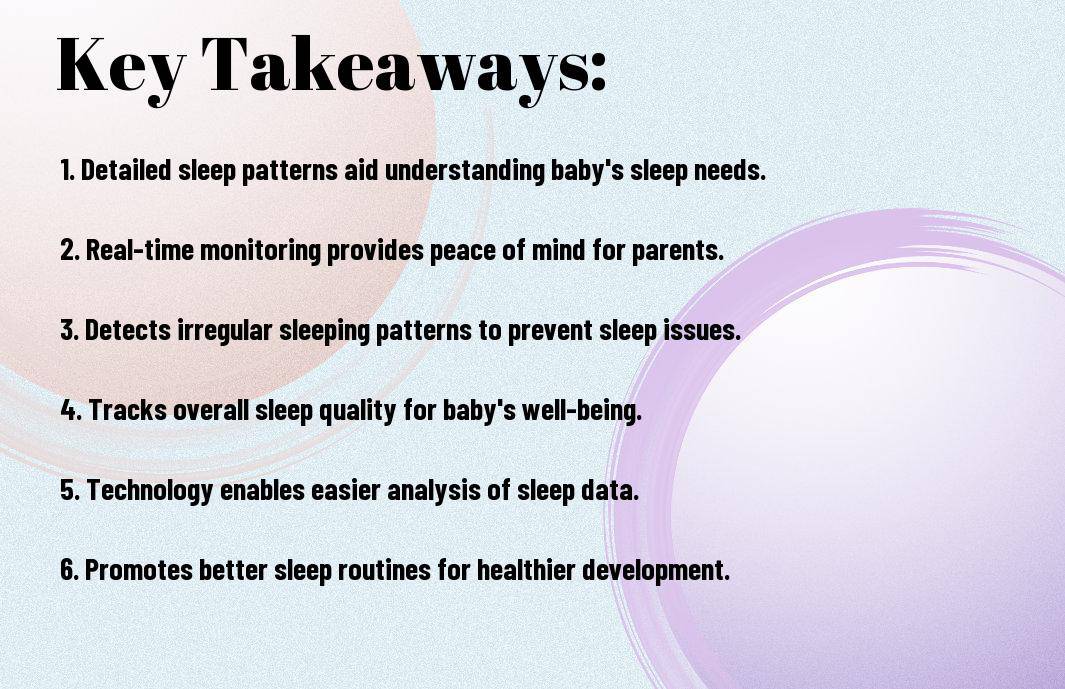tips, tricks and guides for parenthood
As parents, monitoring our baby's sleep patterns can be crucial for their health and our sanity. Advances in technology have made it easier than ever to keep track of our little one's sleep using monitors and apps designed specifically for this purpose. In this blog post, we will explore the benefits of using technology to monitor baby sleep, how it can help us detect any potential issues, and tips on making the most out of these tools. Let's investigate into the world of baby sleep monitoring and how it can provide peace of mind for caregivers.

Understanding the different stages of baby sleep is crucial for monitoring your little one's rest patterns. Babies go through two main types of sleep: REM (Rapid Eye Movement) sleep and non-REM sleep. REM sleep is when most dreaming occurs, and babies spend more time in this stage than adults. Non-REM sleep is further divided into light and deep sleep, with deep sleep being the most restorative phase.
As babies grow and develop, their sleep needs evolve significantly. Newborns require the most sleep, typically between 14-17 hours a day. As they progress into infants and then toddlers, their total sleep time decreases, and they begin to consolidate their sleep into longer stretches at night. By the age of 4, most children no longer need daytime naps and can sleep through the night.
Wearable devices such as smart baby monitors and baby sleep trackers are popular tools for monitoring baby sleep. These devices are typically placed on the baby's clothing or around their wrist, and they track sleep patterns through built-in sensors. The data collected can provide insights into the baby's sleep quality, duration, and any disturbances throughout the night.
Non-contact monitors are another option for parents looking to monitor their baby's sleep without needing to attach any devices to the baby. These monitors use advanced technology such as infrared sensors to detect the baby's movements and breathing patterns from a distance. This type of monitoring offers a non-intrusive way to keep an eye on the baby while they sleep.
Non-contact monitors are particularly useful for parents who are concerned about the risks of using wearable devices on their baby or who simply prefer a more hands-off approach to monitoring their baby's sleep. These monitors can provide real-time data on the baby's sleep patterns and alert parents to any irregularities or potential issues during the night.
Utilising sleep monitoring technology to track your baby's sleep patterns can provide valuable insights into their rest habits. By gathering data on sleep duration, quality, and patterns, parents can make informed decisions on their baby's sleep routine and identify any potential sleep-related issues early on.
While sleep monitoring technology offers benefits, it is important to consider the potential risks and limitations. Privacy concerns regarding the collection and storage of sensitive data, such as your baby's sleep patterns, must be taken into account. Additionally, over-reliance on technology to monitor sleep may lead to unnecessary stress or anxiety for parents.
Parents should also be cautious about the accuracy of the data provided by sleep monitoring devices, as they may not always be 100% precise in measuring sleep parameters. It is crucial to use technology as a tool to complement parental observations, rather than a definitive measure of your baby's sleep health.
Integrating technology into your baby's sleep routine can help you monitor their sleep patterns and ensure they are safe and sound throughout the night. By incorporating sleep monitoring devices into their bedtime routine, you can have peace of mind knowing that you are taking proactive steps to keep your baby safe while they rest.
When dicking out a sleep monitoring device for your baby, it is vital to consider factors such as reliability, accuracy, and ease of use. Look for features like real-time monitoring, temperature sensors, and movement detection to ensure you get the most out of your device. Remember to choose a device that is user-friendly and meets safety standards to provide optimal monitoring of your baby's sleep.
Monitoring baby sleep using technology provides parents with valuable insights into their child's sleep patterns, helping to ensure the baby gets the rest they need for healthy development. By utilising devices such as baby monitors and sleep trackers, parents can track their baby's sleep quality and duration, allowing them to make informed decisions to improve their little one's sleep hygiene. These technological advancements can offer peace of mind to parents, knowing they are keeping a close eye on their baby's well-being even when they are not in the same room. Overall, using technology to monitor baby sleep can enhance the quality of sleep for both the baby and the parents, leading to a happier and healthier family dynamic.
A: Monitoring baby sleep using technology involves using devices such as baby monitors or sleep trackers to keep track of your baby's sleep patterns and ensure they are sleeping safely.
A: Yes, monitoring baby sleep using technology can provide parents with valuable insights into their baby's sleep habits, helping them to identify any potential issues and promote healthy sleep patterns.
A: Common technologies used to monitor baby sleep include video baby monitors, smart baby monitors that track sleep patterns, wearable sleep trackers, and apps that record sleep data.
A: As long as the technology is used correctly and following safety guidelines, monitoring baby sleep using technology is generally safe for the baby and can provide peace of mind for parents.
A: Monitoring baby sleep using technology can help parents track their baby's sleep patterns, identify any sleep issues early on, make informed decisions about sleep training, and ensure their baby is sleeping safely and comfortably.